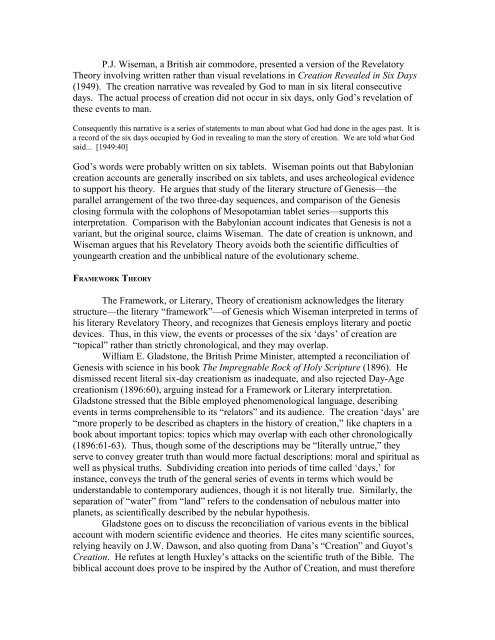Creationism - National Center for Science Education
Creationism - National Center for Science Education
Creationism - National Center for Science Education
You also want an ePaper? Increase the reach of your titles
YUMPU automatically turns print PDFs into web optimized ePapers that Google loves.
P.J. Wiseman, a British air commodore, presented a version of the Revelatory<br />
Theory involving written rather than visual revelations in Creation Revealed in Six Days<br />
(1949). The creation narrative was revealed by God to man in six literal consecutive<br />
days. The actual process of creation did not occur in six days, only God’s revelation of<br />
these events to man.<br />
Consequently this narrative is a series of statements to man about what God had done in the ages past. It is<br />
a record of the six days occupied by God in revealing to man the story of creation. We are told what God<br />
said... [1949:40]<br />
God’s words were probably written on six tablets. Wiseman points out that Babylonian<br />
creation accounts are generally inscribed on six tablets, and uses archeological evidence<br />
to support his theory. He argues that study of the literary structure of Genesis—the<br />
parallel arrangement of the two three-day sequences, and comparison of the Genesis<br />
closing <strong>for</strong>mula with the colophons of Mesopotamian tablet series—supports this<br />
interpretation. Comparison with the Babylonian account indicates that Genesis is not a<br />
variant, but the original source, claims Wiseman. The date of creation is unknown, and<br />
Wiseman argues that his Revelatory Theory avoids both the scientific difficulties of<br />
youngearth creation and the unbiblical nature of the evolutionary scheme.<br />
FRAMEWORK THEORY<br />
The Framework, or Literary, Theory of creationism acknowledges the literary<br />
structure—the literary “framework”—of Genesis which Wiseman interpreted in terms of<br />
his literary Revelatory Theory, and recognizes that Genesis employs literary and poetic<br />
devices. Thus, in this view, the events or processes of the six ‘days’ of creation are<br />
“topical” rather than strictly chronological, and they may overlap.<br />
William E. Gladstone, the British Prime Minister, attempted a reconciliation of<br />
Genesis with science in his book The Impregnable Rock of Holy Scripture (1896). He<br />
dismissed recent literal six-day creationism as inadequate, and also rejected Day-Age<br />
creationism (1896:60), arguing instead <strong>for</strong> a Framework or Literary interpretation.<br />
Gladstone stressed that the Bible employed phenomenological language, describing<br />
events in terms comprehensible to its “relators” and its audience. The creation ‘days’ are<br />
“more properly to be described as chapters in the history of creation,” like chapters in a<br />
book about important topics: topics which may overlap with each other chronologically<br />
(1896:61-63). Thus, though some of the descriptions may be “literally untrue,” they<br />
serve to convey greater truth than would more factual descriptions: moral and spiritual as<br />
well as physical truths. Subdividing creation into periods of time called ‘days,’ <strong>for</strong><br />
instance, conveys the truth of the general series of events in terms which would be<br />
understandable to contemporary audiences, though it is not literally true. Similarly, the<br />
separation of “water” from “land” refers to the condensation of nebulous matter into<br />
planets, as scientifically described by the nebular hypothesis.<br />
Gladstone goes on to discuss the reconciliation of various events in the biblical<br />
account with modern scientific evidence and theories. He cites many scientific sources,<br />
relying heavily on J.W. Dawson, and also quoting from Dana’s “Creation” and Guyot’s<br />
Creation. He refutes at length Huxley’s attacks on the scientific truth of the Bible. The<br />
biblical account does prove to be inspired by the Author of Creation, and must there<strong>for</strong>e

















